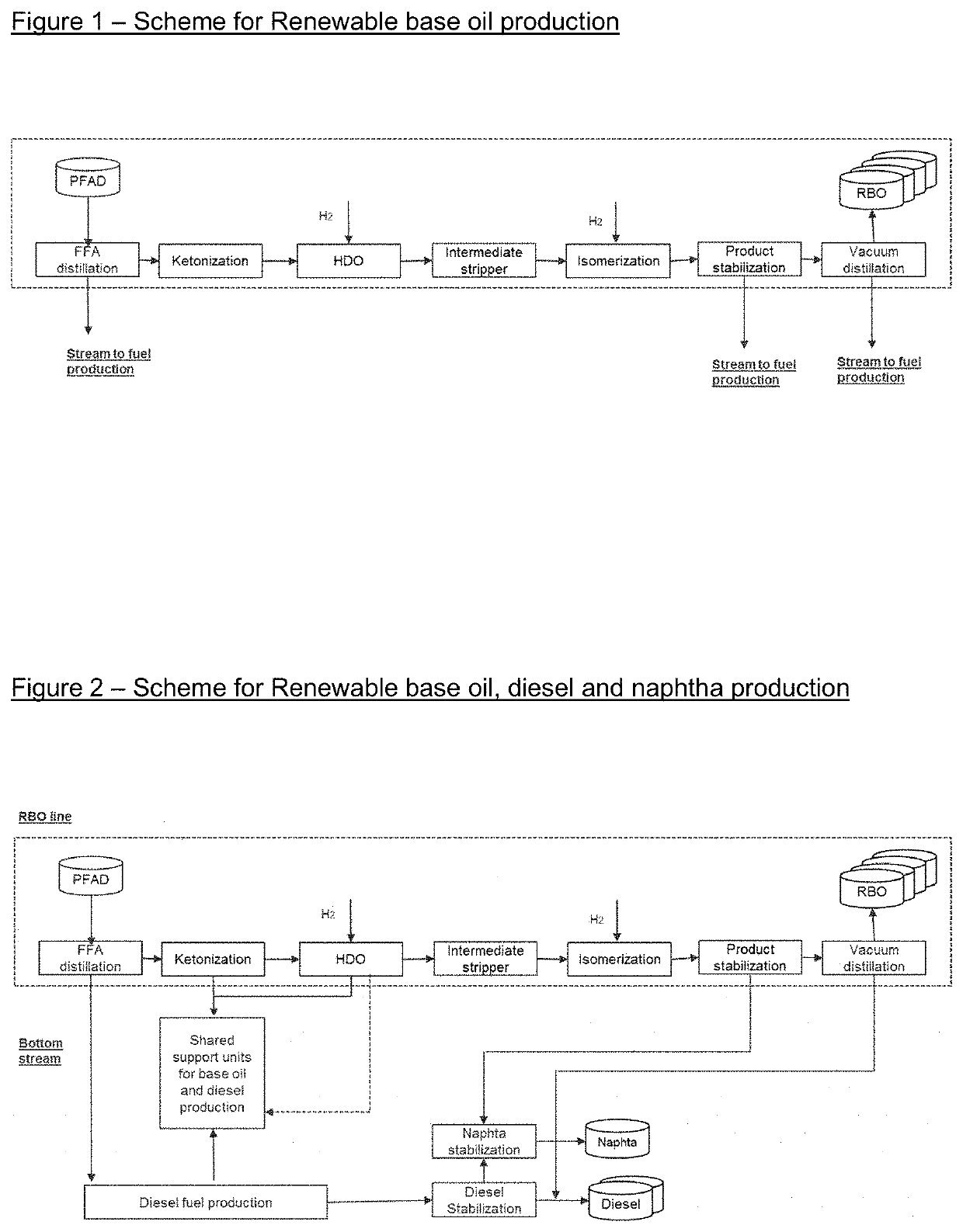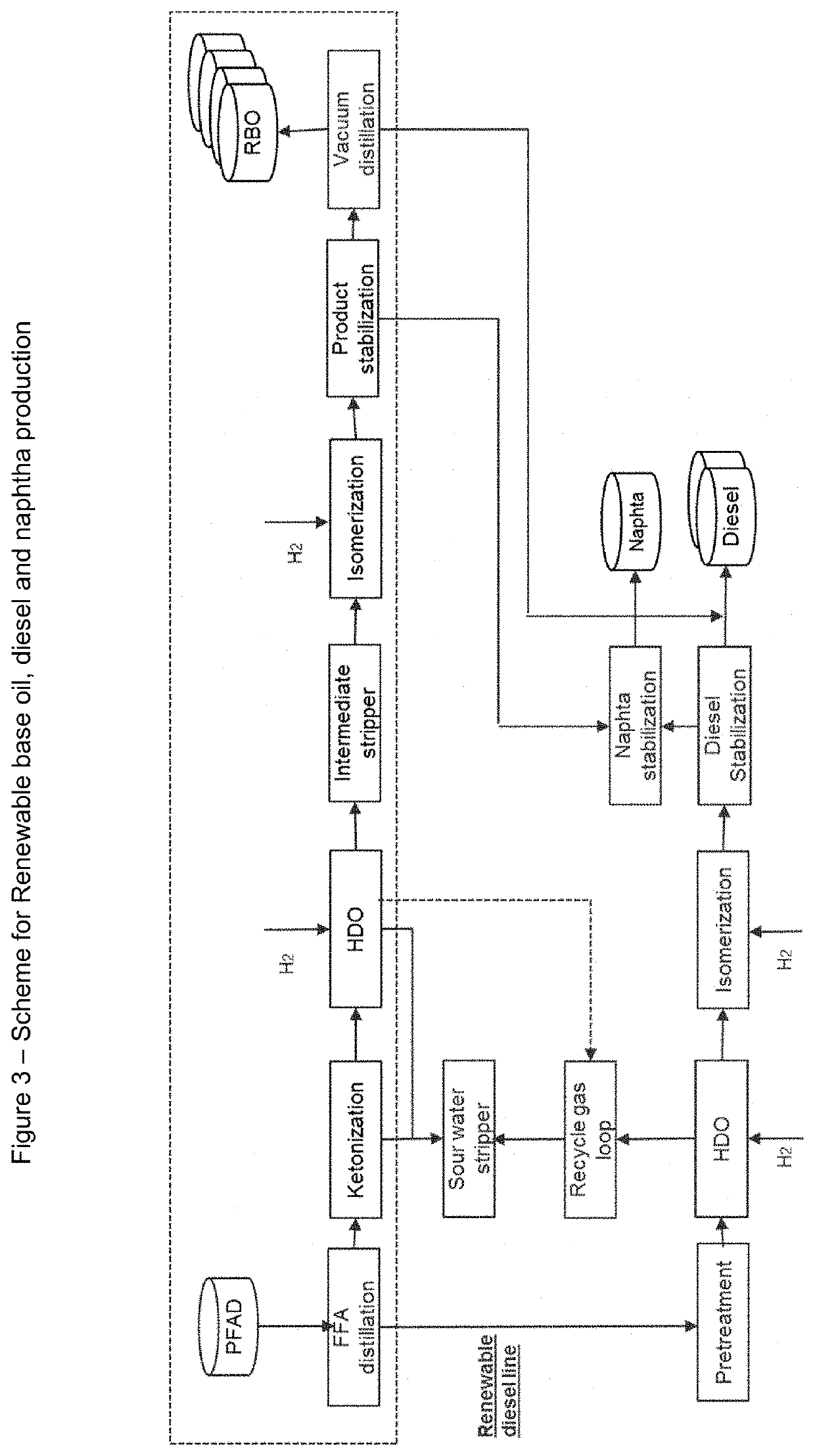Process for the production of renewable base oil, diesel and naphtha
a technology of renewable base oil and diesel, which is applied in the direction of metal/metal-oxide/metal-hydroxide catalyst, hydrocarbon from oxygen organic compounds, chemical/physical processes, etc., can solve the problem of increasing the overall hydrogen amount needed to convert biological oil, increasing the degradation of biological oils used for processing into renewable diesel and renewable base oils, and increasing the complexity of biological oils. , to achieve the effect of increasing catalyst life and reducing hydrogen consumption
- Summary
- Abstract
- Description
- Claims
- Application Information
AI Technical Summary
Benefits of technology
Problems solved by technology
Method used
Image
Examples
example 1
n of PFAD into a Palmitic Acid Feed and a Palmitic Acid Depleted Feed
[0126]Palm fatty acid distillate (PFAD) was separated into a palmitic acid feed and a palmitic acid depleted feed by distillation at a temperature of about 250-275° C. and at 0.01-0.05 bar pressure.
[0127]This resulted in a palmitic acid feed, which was 97.0 wt % pure with minor impurities of: C18 fatty acids (0.42 wt %); C14 fatty acids (2.5 wt %).
[0128]The remaining palmitic acid depleted feed contained partial glycerides and C18 fatty acids as the primary components:
TABLE 1Distillation of PFADCarbon PFAD feed Distillate (wt %)Bottom (wt %)number(wt %)(Enriched feed)(depleted feed)C14:0 FFA1.12.50.0C16:0 FFA42.4970.4C18:2 FFA1.20.22.0C18:1 FFA42.10.274.4C18:0 FFA4.50.018.0MG000.0DG2.604.6TG6.1010.8FFA: free fatty acids; MG, DG, TG: mono-, di-, tri-glyderides
example 2
ion of the Palmitic Acid Feed
[0129]The palmitic acid feed was fed to a fixed bed (pilot) reactor operated in continuous mode comprising a catalyst bed loaded with 250 g catalyst material (TiO2 BET 50-54 m2 / g; average pore size 100-200 Å; crystallinity 50-100%). The ketonisation was conducted in the liquid phase at a pressure of about 18 barg, temperature of about 360° C., WHSV of about 1.0 h−1, and an extra gas flow of 131 l / h nitrogen. The ketonisation reaction conditions resulted in 85% fatty acid conversion thereby obtaining a ketone stream.
example 2a
on of the Palmitic Acid Feed
[0130]The palmitic acid feed was fed to a fixed bed reactor operated in continuous mode comprising a catalyst bed loaded with 250 g catalyst material (TiO2 BET 50-54 m2 / g; average pore size 100-200 Å; crystallinity 50-100%). The ketonisation was conducted in the liquid phase at a pressure of about 25 barg, temperature of about 360° C., WHSV of about 0.5 h−1, without extra gas flow. The ketonisation reaction conditions resulted in 99.9% fatty acid conversion thereby obtaining a ketone stream.
PUM
| Property | Measurement | Unit |
|---|---|---|
| Temperature | aaaaa | aaaaa |
| Temperature | aaaaa | aaaaa |
| Temperature | aaaaa | aaaaa |
Abstract
Description
Claims
Application Information
 Login to View More
Login to View More - R&D
- Intellectual Property
- Life Sciences
- Materials
- Tech Scout
- Unparalleled Data Quality
- Higher Quality Content
- 60% Fewer Hallucinations
Browse by: Latest US Patents, China's latest patents, Technical Efficacy Thesaurus, Application Domain, Technology Topic, Popular Technical Reports.
© 2025 PatSnap. All rights reserved.Legal|Privacy policy|Modern Slavery Act Transparency Statement|Sitemap|About US| Contact US: help@patsnap.com


